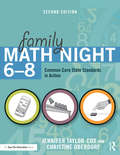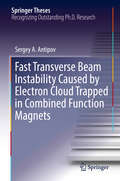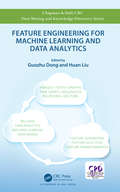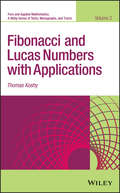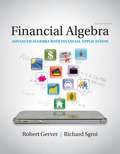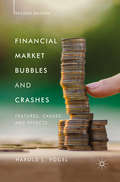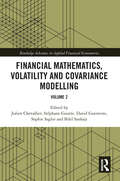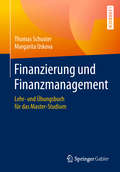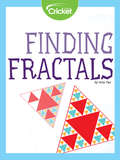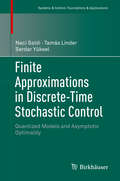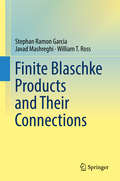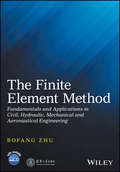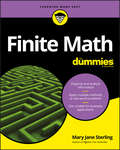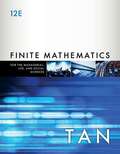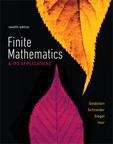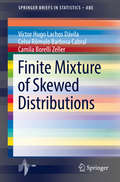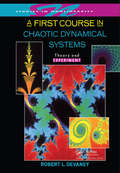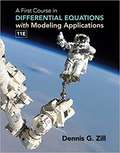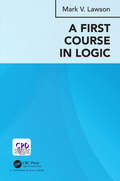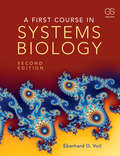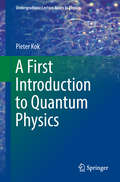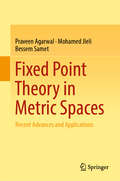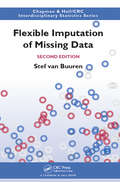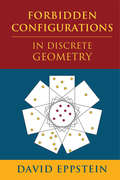- Table View
- List View
Family Math Night 6-8: Common Core State Standards in Action
by Jennifer Taylor-Cox Christine OberdorfHost Family Math Nights at your middle school—starting today! Family Math Nights are a great way for teachers to get parents involved in their children’s education and to promote math learning outside of the classroom. In this practical book, you’ll find step-by-step guidelines and activities to help you bring Family Math Nights to life. The enhanced second edition is aligned with the Common Core State Standards for Mathematical Content and Practice with new activities to help students explain their answers and write about math. It also comes with ready-to-use handouts that you can distribute during your event. With the resources in this book, you’ll have everything you need to help students learn essential math concepts—including ratios and proportional relationships, the number system, expressions and equations, geometry, and statistics and probability—in a fun and supportive environment. Special Features: The book is organized by math content, so you can quickly find activities that meet your needs. Each activity is easy to implement and includes a page of instructions educators can use to prepare the station, as well as a page for families that explains the activity and can be photocopied and displayed at the station. All of the family activities can be photocopied or downloaded from our website, www.routledge.com/9781138200999, so that you can distribute them during your event.
Fast Transverse Beam Instability Caused by Electron Cloud Trapped in Combined Function Magnets (Springer Theses)
by Sergey A. AntipovThis thesis presents profound insights into the origins and dynamics of beam instabilities using both experimental observations and numerical simulations. When the Recycler Ring, a high-intensity proton beam accelerator at Fermi National Accelerator Laboratory, was commissioned, it became evident that the Recycler beam experiences a very fast instability of unknown nature. This instability was so fast that the existing dampers were ineffective at suppressing it. The nature of this phenomenon, alongside several other poorly understood features of the beam, became one of the biggest puzzles in the accelerator community. The author investigated a hypothesis that the instability arises from an interaction with a dense cloud of electrons accompanying the proton beam. He studied the phenomena experimentally by comparing the dynamics of stable and unstable beams, by numerically simulating the build-up of the electron cloud and its interaction with the beam, and by constructing an analytical model of an electron cloud-driven instability with the electrons trapped in combined-function dipole magnets. He has devised a method to stabilize the beam by a clearing bunch, which conclusively revealed that the instability is caused by the electron cloud, trapped in a strong magnetic field. Finally, he conducted measurements of the microwave propagation through a single dipole magnet. These measurements have confirmed the presence of the electron cloud in combined-function magnets.
Feature Engineering for Machine Learning and Data Analytics (Chapman & Hall/CRC Data Mining and Knowledge Discovery Series)
by Guozhu Dong Huan LiuFeature engineering plays a vital role in big data analytics. Machine learning and data mining algorithms cannot work without data. Little can be achieved if there are few features to represent the underlying data objects, and the quality of results of those algorithms largely depends on the quality of the available features. Feature Engineering for Machine Learning and Data Analytics provides a comprehensive introduction to feature engineering, including feature generation, feature extraction, feature transformation, feature selection, and feature analysis and evaluation. The book presents key concepts, methods, examples, and applications, as well as chapters on feature engineering for major data types such as texts, images, sequences, time series, graphs, streaming data, software engineering data, Twitter data, and social media data. It also contains generic feature generation approaches, as well as methods for generating tried-and-tested, hand-crafted, domain-specific features. The first chapter defines the concepts of features and feature engineering, offers an overview of the book, and provides pointers to topics not covered in this book. The next six chapters are devoted to feature engineering, including feature generation for specific data types. The subsequent four chapters cover generic approaches for feature engineering, namely feature selection, feature transformation based feature engineering, deep learning based feature engineering, and pattern based feature generation and engineering. The last three chapters discuss feature engineering for social bot detection, software management, and Twitter-based applications respectively. This book can be used as a reference for data analysts, big data scientists, data preprocessing workers, project managers, project developers, prediction modelers, professors, researchers, graduate students, and upper level undergraduate students. It can also be used as the primary text for courses on feature engineering, or as a supplement for courses on machine learning, data mining, and big data analytics.
Fibonacci and Lucas Numbers with Applications (Pure and Applied Mathematics: A Wiley Series of Texts, Monographs and Tract #51)
by Thomas KoshyVolume II provides an advanced approach to the extended gibonacci family, which includes Fibonacci, Lucas, Pell, Pell-Lucas, Jacobsthal, Jacobsthal-Lucas, Vieta, Vieta-Lucas, and Chebyshev polynomials of both kinds. This volume offers a uniquely unified, extensive, and historical approach that will appeal to both students and professional mathematicians. As in Volume I, Volume II focuses on problem-solving techniques such as pattern recognition; conjecturing; proof-techniques, and applications. It offers a wealth of delightful opportunities to explore and experiment, as well as plentiful material for group discussions, seminars, presentations, and collaboration.In addition, the material covered in this book promotes intellectual curiosity, creativity, and ingenuity. Volume II features: A wealth of examples, applications, and exercises of varying degrees of difficulty and sophistication. Numerous combinatorial and graph-theoretic proofs and techniques. A uniquely thorough discussion of gibonacci subfamilies, and the fascinating relationships that link them. Examples of the beauty, power, and ubiquity of the extended gibonacci family. An introduction to tribonacci polynomials and numbers, and their combinatorial and graph-theoretic models. Abbreviated solutions provided for all odd-numbered exercises. Extensive references for further study. This volume will be a valuable resource for upper-level undergraduates and graduate students, as well as for independent study projects, undergraduate and graduate theses. It is the most comprehensive work available, a welcome addition for gibonacci enthusiasts in computer science, electrical engineering, and physics, as well as for creative and curious amateurs.
Financial Algebra: Advanced Algebra With Financial Applications (Financial Algebra Ser.)
by Robert Gerver Richard SgroiNIMAC-sourced textbook
Financial Market Bubbles and Crashes, Second Edition: Features, Causes, and Effects
by Harold L. VogelEconomists broadly define financial asset price bubbles as episodes in which prices rise with notable rapidity and depart from historically established asset valuation multiples and relationships. Financial economists have for decades attempted to study and interpret bubbles through the prisms of rational expectations, efficient markets, and equilibrium, arbitrage, and capital asset pricing models, but they have not made much if any progress toward a consistent and reliable theory that explains how and why bubbles (and crashes) evolve and can also be defined, measured, and compared. This book develops a new and different approach that is based on the central notion that bubbles and crashes reflect urgent short-side rationing, which means that, as such extreme conditions unfold, considerations of quantities owned or not owned begin to displace considerations of price.
Financial Mathematics, Volatility and Covariance Modelling: Volume 2 (Routledge Advances in Applied Financial Econometrics)
by Julien Chevallier Stéphane Goutte David Guerreiro Sophie Saglio Bilel SanhajiThis book provides an up-to-date series of advanced chapters on applied financial econometric techniques pertaining the various fields of commodities finance, mathematics & stochastics, international macroeconomics and financial econometrics. Financial Mathematics, Volatility and Covariance Modelling: Volume 2 provides a key repository on the current state of knowledge, the latest debates and recent literature on financial mathematics, volatility and covariance modelling. The first section is devoted to mathematical finance, stochastic modelling and control optimization. Chapters explore the recent financial crisis, the increase of uncertainty and volatility, and propose an alternative approach to deal with these issues. The second section covers financial volatility and covariance modelling and explores proposals for dealing with recent developments in financial econometrics This book will be useful to students and researchers in applied econometrics; academics and students seeking convenient access to an unfamiliar area. It will also be of great interest established researchers seeking a single repository on the current state of knowledge, current debates and relevant literature.
Finanzierung und Finanzmanagement: Lehr- Und Übungsbuch Für Das Master-studium
by Thomas Schuster Margarita UskovaDas Buch bietet eine sehr praxisorientierte und vertiefte Darstellung eines Unternehmens. Nach einem kurzen Überblick über die Grundlagen des Finanzmanagements lernt der Leser die Einzelheiten der Beteiligungs-, Fremd- und Innenfinanzierung kennen. Außerdem werden Finanzderivate wie zum Beispiel Optionen und Forward Rate Agreements dargestellt. Ein Kapitel über alternative Finanzierungsinstrumente, beispielsweise Factoring oder Leasing, runden das Lehrbuch ab. In jedem Kapitel führt ein Fallbeispiel in das Wissensgebiet ein. Die einzelnen Themen werden anschaulich durch viele Praxisbeispiele illustriert. Lernkontrollaufgaben dienen der Absicherung, dass der Leser den gelernten Stoff gut verstanden hat. Es handelt sich um ein sehr modernes Lehrbuch mit der konsequenten Verbindung von Theorie, Praxisbeispielen und vertiefenden Übungsaufgaben. Studierende finden zusätzliche Übungsaufgaben und Lösungen auf der Internetseite des Verlags. Für Lehrende werden weitere Materialien – bespielsweise PowerPoint-Folien und Klausuren – auf der Springer-Seite DozentenPLUS bereitgestellt. Das Buch wendet sich an Master-Studierende mit wirtschaftswissenschaftlichem Schwerpunkt, MBA-Studierende sowie an Praktiker in Finanzabteilungen von Unternehmen.
Finding Fractals
by Amy TaoHave you ever seen a fractal? You probably have, and just didn’t know it! These repeating shapes can happen anywhere, whether in nature or in math—it’s easy to make one out of a series of lines and triangles! Follow along and make a fractal of your own in a fun craft.
Finite Approximations in Discrete-Time Stochastic Control: Quantized Models And Asymptotic Optimality (Systems And Control: Foundations And Applications Ser.)
by Serdar Yüksel Tamás Linder Naci SaldiIn a unified form, this monograph presents fundamental results on the approximation of centralized and decentralized stochastic control problems, with uncountable state, measurement, and action spaces. It demonstrates how quantization provides a system-independent and constructive method for the reduction of a system with Borel spaces to one with finite state, measurement, and action spaces. In addition to this constructive view, the book considers both the information transmission approach for discretization of actions, and the computational approach for discretization of states and actions. Part I of the text discusses Markov decision processes and their finite-state or finite-action approximations, while Part II builds from there to finite approximations in decentralized stochastic control problems. This volume is perfect for researchers and graduate students interested in stochastic controls. With the tools presented, readers will be able to establish the convergence of approximation models to original models and the methods are general enough that researchers can build corresponding approximation results, typically with no additional assumptions.
Finite Blaschke Products and Their Connections
by William T. Ross Stephan Ramon Garcia Javad MashreghiThis monograph offers an introduction to finite Blaschke products and their connections to complex analysis, linear algebra, operator theory, matrix analysis, and other fields. Old favorites such as the Carathéodory approximation and the Pick interpolation theorems are featured, as are many topics that have never received a modern treatment, such as the Bohr radius and Ritt's theorem on decomposability. Deep connections to hyperbolic geometry are explored, as are the mapping properties, zeros, residues, and critical points of finite Blaschke products. In addition, model spaces, rational functions with real boundary values, spectral mapping properties of the numerical range, and the Darlington synthesis problem from electrical engineering are also covered.Topics are carefully discussed, and numerous examples and illustrations highlight crucial ideas. While thorough explanations allow the reader to appreciate the beauty of the subject, relevant exercises following each chapter improve technical fluency with the material. With much of the material previously scattered throughout mathematical history, this book presents a cohesive, comprehensive and modern exposition accessible to undergraduate students, graduate students, and researchers who have familiarity with complex analysis.
The Finite Element Method: Fundamentals and Applications in Civil, Hydraulic, Mechanical and Aeronautical Engineering
by ZhuA comprehensive review of the Finite Element Method (FEM), this book provides the fundamentals together with a wide range of applications in civil, mechanical and aeronautical engineering. It addresses both the theoretical and numerical implementation aspects of the FEM, providing examples in several important topics such as solid mechanics, fluid mechanics and heat transfer, appealing to a wide range of engineering disciplines. Written by a renowned author and academician with the Chinese Academy of Engineering, The Finite Element Method would appeal to researchers looking to understand how the fundamentals of the FEM can be applied in other disciplines. Researchers and graduate students studying hydraulic, mechanical and civil engineering will find it a practical reference text.
Finite Math For Dummies
by Mary Jane SterlingUse mathematical analysis in the real world Finite math takes everything you've learned in your previous math courses and brings them together into one course with a focus on organizing and analyzing information, creating mathematical models for approaching business decisions, using statistics principles to understand future states, and applying logic to data organization. Finite Math For Dummies tracks to a typical college-level course designed for business, computer science, accounting, and other non-math majors, and is the perfect supplement to help you score high! Organize and analyze information Apply calculation principles to real-world problems Use models for business calculations Supplement your coursework with step-by-step example problems If you’re not a math person or just want to brush up on your skills to get a better grade, Finite Math For Dummies is your ticket to scoring higher!
Finite Mathematics: For The Managerial, Life, And Social Sciences
by Soo T. TanFINITE MATHEMATICS FOR THE MANAGERIAL, LIFE, AND SOCIAL SCIENCES, Twelfth Edition, is a clear, easy-to-follow text that balances contemporary mathematics applications and the latest technology to help give you the key problem-solving skills you need for your life and career in the 21st century. Real-world applications put math concepts in context and cover topics including social media accounts, corporate fraud, criminal justice, cyber privacy, starting a new job, gas prices, smartphone ownership, mobile ad revenues, and more.
Finite Mathematics & Its Applications (12th Edition)
by Steven M. Hair Larry J. Goldstein David I. Schneider Martha J. SiegelFor Finite Math courses for students majoring in business, economics, life science, or social sciences <p><p> The most relevant choice<p> Finite Mathematics is a comprehensive yet flexible text for students majoring in business, economics, life science, or social sciences. Its varied and relevant applications are designed to pique and hold student interest, and the depth of coverage provides a solid foundation for students’ future coursework and careers. Built-in, optional instruction for the latest technology—graphing calculators, spreadsheets, and WolframAlpha—gives instructors flexibility in deciding how to integrate these tools into their course. Thousands of well-crafted exercises–a hallmark of this text–are available in print and online in MyLab™ Math to enable a wide range of practice in skills, applications, concepts, and technology.<p> In the 12th Edition, new co-author Steve Hair (Pennsylvania State University) brings a fresh eye to the content and MyLab™ Math course based on his experience in the classroom. In addition to its updated applications, exercises, and technology coverage, the revision infuses modern topics such as health statistics and content revisions based on user feedback. The authors relied on aggregated student usage and performance data from MyLab™ Math to improve the quality and quantity of exercises.
Finite Mixture of Skewed Distributions (SpringerBriefs in Statistics)
by Víctor Hugo Lachos Dávila Celso Rômulo Cabral Camila Borelli ZellerThis book presents recent results in finite mixtures of skewed distributions to prepare readers to undertake mixture models using scale mixtures of skew normal distributions (SMSN). For this purpose, the authors consider maximum likelihood estimation for univariate and multivariate finite mixtures where components are members of the flexible class of SMSN distributions. This subclass includes the entire family of normal independent distributions, also known as scale mixtures of normal distributions (SMN), as well as the skew-normal and skewed versions of some other classical symmetric distributions: the skew-t (ST), the skew-slash (SSL) and the skew-contaminated normal (SCN), for example. These distributions have heavier tails than the typical normal one, and thus they seem to be a reasonable choice for robust inference. The proposed EM-type algorithm and methods are implemented in the R package mixsmsn, highlighting the applicability of the techniques presented in the book.This work is a useful reference guide for researchers analyzing heterogeneous data, as well as a textbook for a graduate-level course in mixture models. The tools presented in the book make complex techniques accessible to applied researchers without the advanced mathematical background and will have broad applications in fields like medicine, biology, engineering, economic, geology and chemistry.
A First Course In Chaotic Dynamical Systems: Theory And Experiment (Studies In Nonlinearity Ser.)
by Robert L. DevaneyA First Course in Chaotic Dynamical Systems: Theory and Experiment is the first book to introduce modern topics in dynamical systems at the undergraduate level. Accessible to readers with only a background in calculus, the book integrates both theory and computer experiments into its coverage of contemporary ideas in dynamics. It is designed as a gradual introduction to the basic mathematical ideas behind such topics as chaos, fractals, Newton's method, symbolic dynamics, the Julia set, and the Mandelbrot set, and includes biographies of some of the leading researchers in the field of dynamical systems. Mathematical and computer experiments are integrated throughout the text to help illustrate the meaning of the theorems presented. Chaotic Dynamical Systems Software, Labs 1-6 is a supplementary labouratory software package, available separately, that allows a more intuitive understanding of the mathematics behind dynamical systems theory. Combined with A First Course in Chaotic Dynamical Systems , it leads to a rich understanding of this emerging field.
A First Course In Differential Equations With Modeling Applications
by Dennis G. ZillStraightforward and easy to read, A FIRST COURSE IN DIFFERENTIAL EQUATIONS WITH MODELING APPLICATIONS, 11th Edition, gives you a thorough overview of the topics typically taught in a first course in differential equations. Your study of differential equations and its applications will be supported by a bounty of pedagogical aids, including an abundance of examples, explanations, ""Remarks"" boxes, definitions, and more.
A First Course in Logic
by Mark Verus LawsonA First Course in Logic is an introduction to first-order logic suitable for first and second year mathematicians and computer scientists. There are three components to this course: propositional logic; Boolean algebras; and predicate/first-order, logic. Logic is the basis of proofs in mathematics — how do we know what we say is true? — and also of computer science — how do I know this program will do what I think it will? Surprisingly little mathematics is needed to learn and understand logic (this course doesn't involve any calculus). The real mathematical prerequisite is an ability to manipulate symbols: in other words, basic algebra. Anyone who can write programs should have this ability.
A First Course in Quantitative Finance
by Thomas MazzoniThis new and exciting book offers a fresh approach to quantitative finance and utilizes novel new features, including stereoscopic images which permit 3D visualization of complex subjects without the need for additional tools. Offering an integrated approach to the subject, A First Course in Quantitative Finance introduces students to the architecture of complete financial markets before exploring the concepts and models of modern portfolio theory, derivative pricing, and fixed-income products in both complete and incomplete market settings. Subjects are organized throughout in a way that encourages a gradual and parallel learning process of both the economic concepts and their mathematical descriptions, framed by additional perspectives from classical utility theory, financial economics, and behavioral finance. Suitable for postgraduate students studying courses in quantitative finance, financial engineering, and financial econometrics as part of an economics, finance, econometric, or mathematics program, this book contains all necessary theoretical and mathematical concepts and numerical methods, as well as the necessary programming code for porting algorithms onto a computer.
A First Course in Systems Biology
by Eberhard VoitA First Course in Systems Biology is an introduction for advanced undergraduate and graduate students to the growing field of systems biology. Its main focus is the development of computational models and their applications to diverse biological systems. The book begins with the fundamentals of modeling, then reviews features of the molecular inventories that bring biological systems to life and discusses case studies that represent some of the frontiers in systems biology and synthetic biology. In this way, it provides the reader with a comprehensive background and access to methods for executing standard systems biology tasks, understanding the modern literature, and launching into specialized courses or projects that address biological questions using theoretical and computational means. New topics in this edition include: default modules for model design, limit cycles and chaos, parameter estimation in Excel, model representations of gene regulation through transcription factors, derivation of the Michaelis-Menten rate law from the original conceptual model, different types of inhibition, hysteresis, a model of differentiation, system adaptation to persistent signals, nonlinear nullclines, PBPK models, and elementary modes. The format is a combination of instructional text and references to primary literature, complemented by sets of small-scale exercises that enable hands-on experience, and large-scale, often open-ended questions for further reflection.
A First Introduction to Quantum Physics (Undergraduate Lecture Notes in Physics)
by Pieter KokIn this undergraduate textbook, the author develops the quantum theory from first principles based on very simple experiments: a photon travelling through beam splitters to detectors, an electron moving through a Stern-Gerlach machine, and an atom emitting radiation. From the physical description of these experiments follows a natural mathematical description in terms of matrices and complex numbers. The first part of the book examines how experimental facts force us to let go of some deeply held preconceptions and develops this idea into a mathematical description of states, probabilities, observables, and time evolution using physical applications. The second part of the book explores more advanced topics, including the concept of entanglement, the process of decoherence, and extension of the quantum theory to the situation of a particle in a one-dimensional box. Here, the text makes contact with more traditional treatments of quantum mechanics. The remaining chapters delve deeply into the idea of uncertainty relations and explore what the quantum theory says about the nature of reality. The book is an ideal and accessible introduction to quantum physics, with modern examples and helpful end-of-chapter exercises.
Fixed Point Theory in Metric Spaces: Recent Advances and Applications
by Praveen Agarwal Mohamed Jleli Bessem SametThis book provides a detailed study of recent results in metric fixed point theory and presents several applications in nonlinear analysis, including matrix equations, integral equations and polynomial approximations. Each chapter is accompanied by basic definitions, mathematical preliminaries and proof of the main results. Divided into ten chapters, it discusses topics such as the Banach contraction principle and its converse; Ran-Reurings fixed point theorem with applications; the existence of fixed points for the class of α-ψ contractive mappings with applications to quadratic integral equations; recent results on fixed point theory for cyclic mappings with applications to the study of functional equations; the generalization of the Banach fixed point theorem on Branciari metric spaces; the existence of fixed points for a certain class of mappings satisfying an implicit contraction; fixed point results for a class of mappings satisfying a certain contraction involving extended simulation functions; the solvability of a coupled fixed point problem under a finite number of equality constraints; the concept of generalized metric spaces, for which the authors extend some well-known fixed point results; and a new fixed point theorem that helps in establishing a Kelisky–Rivlin type result for q-Bernstein polynomials and modified q-Bernstein polynomials.The book is a valuable resource for a wide audience, including graduate students and researchers.
Flexible Imputation of Missing Data (Chapman & Hall/CRC Interdisciplinary Statistics)
by Stef Van BuurenMissing data pose challenges to real-life data analysis. Simple ad-hoc fixes, like deletion or mean imputation, only work under highly restrictive conditions, which are often not met in practice. Multiple imputation replaces each missing value by multiple plausible values. The variability between these replacements reflects our ignorance of the true (but missing) value. Each of the completed data set is then analyzed by standard methods, and the results are pooled to obtain unbiased estimates with correct confidence intervals. Multiple imputation is a general approach that also inspires novel solutions to old problems by reformulating the task at hand as a missing-data problem. This is the second edition of a popular book on multiple imputation, focused on explaining the application of methods through detailed worked examples using the MICE package as developed by the author. This new edition incorporates the recent developments in this fast-moving field. This class-tested book avoids mathematical and technical details as much as possible: formulas are accompanied by verbal statements that explain the formula in accessible terms. The book sharpens the reader’s intuition on how to think about missing data, and provides all the tools needed to execute a well-grounded quantitative analysis in the presence of missing data.
Forbidden Configurations in Discrete Geometry
by David EppsteinThis book surveys the mathematical and computational properties of finite sets of points in the plane, covering recent breakthroughs on important problems in discrete geometry, and listing many open problems. It unifies these mathematical and computational views using forbidden configurations, which are patterns that cannot appear in sets with a given property, and explores the implications of this unified view.<P><P> Written with minimal prerequisites and featuring plenty of figures, this engaging book will be of interest to undergraduate students and researchers in mathematics and computer science. Most topics are introduced with a related puzzle or brain-teaser. The topics range from abstract issues of collinearity, convexity, and general position to more applied areas including robust statistical estimation and network visualization, with connections to related areas of mathematics including number theory, graph theory, and the theory of permutation patterns. Pseudocode is included for many algorithms that compute properties of point sets.<P> Proposes a unified view of problems in discrete geometry, helping readers understand the connections and commonalities between problems in the area.<P> Combines mathematical and computational views of the subject, and pseudocode for numerous algorithms, providing a readable introduction for computer science and mathematics students.<P> The book is accessible and motivating, featuring both recreational puzzles along with recent breakthroughs and open problems.
